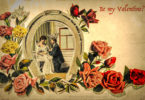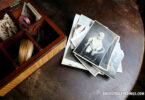If you are of German descent, there are probably some unique holiday traditions your family practices, especially if that German ancestry in your family is recent. You may have some relatives still with you who actually came from Germany, in which case many of these traditions will be familiar. If your German ancestry was farther back in time, these interesting and fun German Christmas traditions will give you a better idea of who your German ancestors were and what their lives were like. You may even want to bring some of these holiday traditions back to your current family, so you can honor your ancestors. They will also definitely make the holidays more interesting.
Here are some of the top German Christmas traditions you should know about.
Advent
Germans actually begin celebrating Christmas four Sundays before Christmas Day. The first of these Sundays is called Advent. On Advent, stolen is eaten, usually in great quantities. Stollen is the oldest documented food created specifically to eat on Christmas in Germany. It is a cake that is filled with chopped fruit, nuts, and spices, and usually sprinkled with powdered sugar.
Lebkuchen is also eaten on Advent and during the rest of the Christmas season. It is kind of like gingerbread, and contains honey, spices, and nuts; it can be made hard or soft and served with or without icing. If you buy your Lebkuchen at a fair or street market, it may also have holiday messages written on it in icing.
Other signs and celebrations of Advent include making gingerbread houses, putting up nativity scenes, and decorating with wooden nutcrackers and Christmas pyramids.
The Advent Wreath
The Advent wreath is used on all four Sundays before Christmas. It is a homemade wreath (it HAS to be homemade) that has four candles on it. One candle is lit each of the four Sundays before Christmas. This tradition first began in the 1800s. Originally, there were nineteen smaller candles on it, too, which were used to help children count down the days until Christmas, but today, only the four Sunday candles are used.
The Advent Calendar
Most people are familiar with this one, even if they are not German or of German descent. However, it is a German invention. It was designed to more fully involve children in the celebrations leading up to Christmas. The calendars have twenty-four windows or doors, and one is opened each day from the beginning of Advent up to Christmas. Each window or door on the calendar has something behind it to delight the children. In the past, it was a Christmas scene. These days, it is usually chocolate or a small toy. The first ones were made in the mid-1800s, with the first mass-produced, printed ones being made in Munich in 1903. Before the invention of the Advent Calendar, families would put a chalk mark on the wall to mark the days from Advent to Christmas.
The Christmas Markets
The Christmas markets are a beloved tradition in Germany and have been around since, at last, the 1300s. They are still being done today. In fact, they appear in nearly every German town during the holiday season. During the winter months, town squares in Germany are usually pretty dark, but the nighttime markets light them up with holiday lights, live brass music, drinks, cider, food, treats for the children, Christmas tree decorations, toys, and other seasonal items galore. They are like giant, holiday-themed nighttime farmer’s markets.
Each town or region in Germany usually has its own particular thing that its Christmas market is famous for, such as the gingerbread men at Aachen, the handmade wooden crafts at Erzgebirge, the life-sized Advent calendar and angel play at Augsburg, and the prune treats and almond cookies at Brenten. However, the most famous of the Christmas markets in the modern era is the one at Nuremberg, which is famous for its gold foil angels and gingerbread cakes. This particular Christmas market is almost four centuries old, and one of the largest in modern Germany, with more than two hundred vendors participating each year.
St. Nicholas
Germans celebrate St. Nicholas Day on the sixth of December as one of the mini-celebrations leading up to Christmas. On St. Nicholas Day, children put clean (usually newly cleaned) shoes in front of the front door to their home, with the hope that St. Nicholas will come and fill up the shoes with fruit, nuts, candy, and chocolate. Only good children get these treats, however. Bad children get nothing or a piece of coal.
St. Nicholas was a real person who lived in the 300s A.D. He was the bishop of what is modern-day Turkey. He was known as a man of good works who gave generously to charities and had a particular fondness for making things good for children, to make up for his own rough childhood. He is now known as the protector of children, and as the one who bestows gifts on them at the holidays. St. Nicholas Day is celebrated on December 6 because that was (and is) Nicholas’s feast day in the Catholic church.
However, during the Reformation, Martin Luther did not like the veneration of any saints and sought to abolish the custom. The people resisted, so instead of St. Nicholas bringing treats to children on the feast day, he changed the tradition so that it was the baby Jesus who did it. This day, held the same day as St. Nicholas Day, is still celebrated by some Protestants in Germany, and is called Christkindl.
The Christmas Tree
In Germany, the Christmas tree is usually put up on Christmas Eve, though some families do it sooner. It can be done at any time during the Advent season, though Christmas Eve is traditional. Originally, the fir tree was used, but these days it is the spruce that is favored for the tree. It is topped with a star or an angel, and a nativity scene is set up under it, next to the presents. Instead of electric lights, genuine lit candles are still used on German Christmas trees, even into the modern times.
The first documented Christmas tree was put up in 1419 in the town of Freiburg by the bakers of the town, who decorated it with baked goods, fruits, and nuts. On New Year’s Day, the children of the town were allowed to eat the goodies on the tree. Later, town guilds brought the trees inside their guild houses, and they decorated them with apples and candy. Later in the Middle Ages, candles were added to the trees.
Beginning in the Middle Ages, ordinary German citizens were already bringing evergreen herbs into their homes for Christmas, such as juniper, mistletoe, yew, and holly. By the 1800s, the tradition of the Christmas tree as we know it today was firmly established in Germany, and others in Europe began to adopt the tradition. Eventually, the Christmas tree made its way to America with German immigrants, who introduced it to their new neighbors, beginning in Ohio and Pennsylvania.
There are three different acceptable times for taking down the Christmas tree in Germany. These times are New Year’s Day, January 6, or Three Kings Day. When the tree is taken down, children can eat any sweets or candy that is still on the tree.
Christmas Eve
Germans celebrate Christmas Eve like other people, but with their own unique spin on it. The day begins as a regular workday, but everyone takes off by 2 pm or sometimes earlier. Businesses close, and everyone begins to prepare for Christmas Eve and Christmas celebrations. There is a traditional Christmas Eve meal that consists of potato salad and carp or sausage. This is meant to be a light meal before the feasting of the next two days. The families sing Christmas carols together and read the story of the birth of Jesus aloud. Gifts are exchanged now, instead of on Christmas morning, and children are the focus of this event. Most families and individuals also attend church on Christmas Eve, even if they are not regular church-goers. Services have traditionally taken place at midnight on Christmas Eve, but have been moved earlier in the evening in more recent times.
Christmas Day
Christmas Day is actually two days in Germany, known as the First and Second Christmases. The first Christmas was originally a church celebration but later became a family one. With businesses being closed, people spend the first Christmas visiting friends and family. Goose is traditionally eaten on this day, with rabbit or roast being alternative choices. The meat is the central dish of the feast this day and is served with traditional German foods like sausage, stuffing with apples and sausage, potato dumplings, red cabbage, and other such things. The second Christmas day is reserved for quiet, peaceful contemplation.
Krampus
Despite a horror movie being done about this, Krampus is an actual German Christmas celebration. Krampus is a sidekick of St. Nick, accompanying him on his rounds to punish naughty children and teach them a lesson. This tradition has been in Germany for a while, at least a few centuries, and even today, men in Krampus costumes patrol the streets in southern Bavaria on St. Nicholas Night. They are there mostly to scare the children. However, if a child has been (or is being) particularly naughty, the parents may invite a Krampus in to take care of it.
Mulled Wine
Everyone loves mulled wine in Germany. It is always served in mugs and steaming hot. In fact, it is sold in ceramic markets in just about every Christmas market in Germany. The holiday is not considered complete without it. It is used to guard against the chill of the season, and to bring good holiday cheer.
Epiphany
January 6 is known as Epiphany in Germany, and it is the day of a Catholic religious feast called the Three Kings Festival. Children dressed up as the three Magi go from house to houses like trick or treating, but instead of asking for candy, they sing songs, usually Christmas carols, and request donations for a variety of children’s charities. The children in their Magi costumes are known as Sternsinger, which translates to “star singer.”
Feuerzangenbowle
This is an essential part of the holiday season in Germany, and it is an incredibly potent Christmas beverage. It is elaborate, and a feast for the eyes as much as the tongue. It is made with rum with a higher than average level of alcohol, which is mixed with mulled wine, and the beverage is then set aflame. When the flames go out, it is safe to drink it (the flames burn off some of the excessive alcohol content). This drink is so popular that there is even a movie about it called Die Feuerzangenbowle, which was made in 1944. It is about a man who is under the influence of Feuerzangenbowle, and the hilarious deeds he does while high on the drink.
Christmas Angels
The German people love their Christmas angels. In fact, they are the most beloved Christmas ornaments in the country. You would have a hard time finding a Christmas tree in Germany without Christmas angels on it. The angels are usually made of wood and are typically depicted playing musical instruments. You will also find thousands of these for sale in literally any Christmas markets in Germany.
As you can see, Germany has quite a few unique Christmas traditions. Some of them have been adopted by the rest of the world, while others have remained uniquely German. If you have German ancestry, either past or present, these are some of the traditions that you can study, observe, and even practice to learn more about your German ancestors and how they lived, and to feel closer to them. You can also adopt these traditions into your own holiday traditions in order to celebrate your German ancestry.




